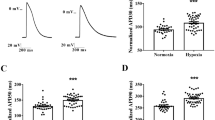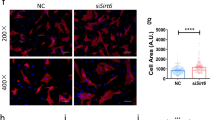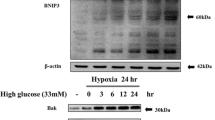Abstract
Spexin (SPX) is a novel peptide with pleiotropic functions in adipose tissue including energy balance adjustment, fatty acid uptake, and glucose homeostasis. SPX level is closely associated with cardiovascular risk factors such as age, obesity, hypertension, and diabetes; however, its physiological significance in the cardiovascular system remains mostly undefined. We therefore here investigated the roles of SPX in regulating hypoxia-induced alterations in energy metabolism and mitochondrial function. We firstly confirmed that SPX is expressed in human and mouse cardiac tissue and documented that exposure to hypoxia in vitro reduces SPX level in rat H9C2 cardiomyocytes and primary neonatal rat ventricular myocytes (NRVMs). We then treated primary NRVMs with SPX before exposure to hypoxia, which (1) promoted fatty acid metabolism by enhancing expression of FAT/CD36, CPT1, ACADM, and PPAR-a and PGC1-a; (2) did not improve impaired glucose uptake; and (3) significantly prevented the downregulation of TFAM and mitochondrial electron transport chain complex and restrained UCP2 level and reactive oxygen species (ROS) production, thus enhancing ATP level in cardiomyocytes. In summary, SPX protects energy and mitochondrial homeostasis of cardiomyocytes during hypoxia, thereby highlighting the potential importance of SPX in the treatment of cardiovascular diseases.





Similar content being viewed by others
References
Abe H, Semba H, Takeda N (2017) The roles of hypoxia signaling in the pathogenesis of cardiovascular diseases. J Atheroscler Thromb 24:884–894
Azzouzi HE, Leptidis S, Doevendans PA, De Windt LJ (2015) HypoxamiRs: regulators of cardiac hypoxia and energy metabolism. Trends Endocrinol Metab 26:502–508
Bertero E, Maack C (2018) Metabolic remodelling in heart failure. Nat Rev Cardiol 15:457–470
Cadenas S (2018) Mitochondrial uncoupling, ROS generation and cardioprotection. Biochim Biophys Acta Bioenerg 1859:940–950
Das S, Ferlito M, Kent OA, Fox-Talbot K, Wang R, Liu D, Raghavachari N, Yang Y, Wheelan SJ, Murphy E, Steenbergen C (2012) Nuclear miRNA regulates the mitochondrial genome in the heart. Circ Res 110:1596–1603
Fang P, Zhang L, Yu M, Sheng Z, Shi M, Zhu Y, Zhang Z, Bo P (2018) Activiated galanin receptor 2 attenuates insulin resistance in skeletal muscle of obese mice. Peptides 99:92–98
Ge JF, Walewski JL, Anglade D, Berk PD (2016) Regulation of hepatocellular fatty acid uptake in mouse models of fatty liver disease with and without functional leptin signaling: roles of NfKB and SREBP-1C and the effects of Spexin. Semin Liver Dis 36:360–372
Gu L, Ma Y, Gu M, Zhang Y, Yan S, Li N, Wang Y, Ding X, Yin J, Fan N, Peng Y (2015) Spexin peptide is expressed in human endocrine and epithelial tissues and reduced after glucose load in type 2 diabetes. Peptides 71:232–239
Kolodziejski PA, Pruszynska-Oszmalek E, Micker M, Skrzypski M, Wojciechowicz T, Szwarckopf P, Skieresz-Szewczyk K, Nowak KW, Strowski MZ (2018) Spexin: a novel regulator of adipogenesis and fat tissue metabolism. Biochim Biophys Acta Mol Cell Biol Lipids 1863:1228–1236
Kuang M, Febbraio M, Wagg C, Lopaschuk GD, Dyck JR (2004) Fatty acid translocase/CD36 deficiency does not energetically or functionally compromise hearts before or after ischemia. Circulation 109:1550–1557
Kumar S, Hossain MJ, Javed A, Kullo IJ, Balagopal PB (2018) Relationship of circulating spexin with markers of cardiovascular disease: a pilot study in adolescents with obesity. Pediatr Obes 13:374–380
Kunkel GH, Chaturvedi P, Tyagi SC (2016) Mitochondrial pathways to cardiac recovery: TFAM. Heart Fail Rev 21:499–517
Kunkel GH, Kunkel CJ, Ozuna H, Miralda I, Tyagi SC (2018) TFAM overexpression reduces pathological cardiac remodeling. Mol Cell Biochem 454:139–152
Lin CY, Zhang M, Huang T, Yang LL, Fu HB, Zhao L, Zhong LL, Mu HX, Shi XK, Leung CF, Fan BM, Jiang M, Lu AP, Zhu LX, Bian ZX (2015) Spexin enhances bowel movement through activating L-type voltage-dependent calcium channel via Galanin receptor 2 in mice. Sci Rep 5:12095
Lin CY, Huang T, Zhao L, Zhong LLD, Lam WC, Fan BM, Bian ZX (2018a) Circulating Spexin levels negatively correlate with age, BMI, fasting glucose, and triglycerides in healthy adult women. J Endocr Soc 2:409–419
Lin CY, Zhao L, Huang T, Lu L, Khan M, Liu J, Zhong LLD, Cai ZW, Fan BM, Wong AOL, Bian ZX (2018b) Spexin acts as novel regulator for bile acid synthesis. Front Physiol 9:378
Liu Y, Li S, Qi X, Zhou W, Liu X, Lin H, Zhang Y, Cheng CH (2013) A novel neuropeptide in suppressing luteinizing hormone release in goldfish, Carassius auratus. Mol Cell Endocrinol 374:65–72
Ma A, He M, Bai J, Wong MK, Ko WK, Wong AO (2017) Dual role of insulin in Spexin regulation: functional link between food intake and Spexin expression in a fish model. Endocrinology 158:560–577
Porzionato A, Rucinski M, Macchi V, Stecco C, Malendowicz LK, De Caro R (2010) Spexin expression in normal rat tissues. J Histochem Cytochem 58:825–837
Porzionato A, Rucinski M, Macchi V, Stecco C, Sarasin G, Sfriso MM, Di Giulio C, Malendowicz LK, De Caro R (2012) Spexin is expressed in the carotid body and is upregulated by postnatal hyperoxia exposure. Adv Exp Med Biol 758:207–213
Sassek M, Kolodziejski PA, Strowski MZ, Nogowski L, Nowak KW, Mackowiak P (2018) Spexin modulates functions of rat endocrine pancreatic cells. Pancreas 47:904–909
Sun L, Yan S, Wang X, Zhao S, Li H, Wang Y, Lu S, Dong X, Zhao J, Yu S, Li M, Li Y (2017) Metoprolol prevents chronic obstructive sleep apnea-induced atrial fibrillation by inhibiting structural, sympathetic nervous and metabolic remodeling of the atria. Sci Rep 7:14941
Tao L, Wang L, Yang X, Jiang X, Hua F (2019) Recombinant human glucagon-like peptide-1 protects against chronic intermittent hypoxia by improving myocardial energy metabolism and mitochondrial biogenesis. Mol Cell Endocrinol 481:95–103
Toll L, Khroyan TV, Sonmez K, Ozawa A, Lindberg I, McLaughlin JP, Eans SO, Shahien AA, Kapusta DR (2012) Peptides derived from the prohormone proNPQ/spexin are potent central modulators of cardiovascular and renal function and nociception. FASEB J 26:947–954
Walewski JL, Ge F, Lobdell H, Levin N, Schwartz GJ, Vasselli JR, Pomp A, Dakin G, Berk PD (2014) Spexin is a novel human peptide that reduces adipocyte uptake of long chain fatty acids and causes weight loss in rodents with diet-induced obesity. Obesity (Silver Spring) 22:1643–1652
Wenz T (2013) Regulation of mitochondrial biogenesis and PGC-1alpha under cellular stress. Mitochondrion 13:134–142
Wong MK, Sze KH, Chen T, Cho CK, Law HC, Chu IK, Wong AO (2013) Goldfish spexin: solution structure and novel function as a satiety factor in feeding control. Am J Physiol Endocrinol Metab 305:E348–E366
Yuan Y, Zhang Y, Han X, Li Y, Zhao X, Sheng L, Li Y (2017) Relaxin alleviates TGFbeta1-induced cardiac fibrosis via inhibition of Stat3-dependent autophagy. Biochem Biophys Res Commun 493:1601–1607
Yuan Y, Zhao J, Gong Y, Wang D, Wang X, Yun F, Liu Z, Zhang S, Li W, Zhao X, Sun L, Sheng L, Pan Z, Li Y (2018) Autophagy exacerbates electrical remodeling in atrial fibrillation by ubiquitin-dependent degradation of L-type calcium channel. Cell Death Dis 9:873
Zheng B, Li S, Liu Y, Li Y, Chen H, Tang H, Liu X, Lin H, Zhang Y, Cheng CHK (2017) Spexin suppress food intake in zebrafish: evidence from gene knockout study. Sci Rep 7:14643
Funding
This work was supported by the Key Program of the National Natural Science Foundation of China (81830012), General Program of the National Natural Science Foundation of China (81670297, 81800332), and Doctoral Fund of Ministry of Education of Heilongjiang Province (LBH-Z17180).
Author information
Authors and Affiliations
Contributions
YL and LS conducted the experiments, analyzed the data, and supervised and wrote the manuscript; LQZ participated equally in the first authorship and conducted experiments, drafted the figure, and analyzed the data and co-wrote the manuscript; MQS, HL, YW, and YKW conducted the experiments and analyzed the data; DL, CGD and CYZ performed the experimental approaches and data to the work; YTG co-wrote the manuscript and revised it for critically important intellectual content; YL* helped to identify and formulate the research and interpreted the experiments. All the authors approved the final version of the manuscript.
Corresponding author
Ethics declarations
All patients recruited into the study signed written informed consent and the study complied with the principles that govern the use of human tissues outlined in the Declaration of Helsinki. Left atrial appendages were obtained as surgical specimens from patients undergoing cardiac surgery for mitral valve replacement, following established procedures approved by Ethic Committee of the Harbin Medical University. The specimens were stored in liquid nitrogen immediately and transported to laboratory
Conflict of interest
The authors declare that they have no conflicts of interest.
Additional information
Publisher’s note
Springer Nature remains neutral with regard to jurisdictional claims in published maps and institutional affiliations.
Rights and permissions
About this article
Cite this article
Liu, Y., Sun, L., Zheng, L. et al. Spexin protects cardiomyocytes from hypoxia-induced metabolic and mitochondrial dysfunction. Naunyn-Schmiedeberg's Arch Pharmacol 393, 25–33 (2020). https://doi.org/10.1007/s00210-019-01708-0
Received:
Accepted:
Published:
Issue Date:
DOI: https://doi.org/10.1007/s00210-019-01708-0




